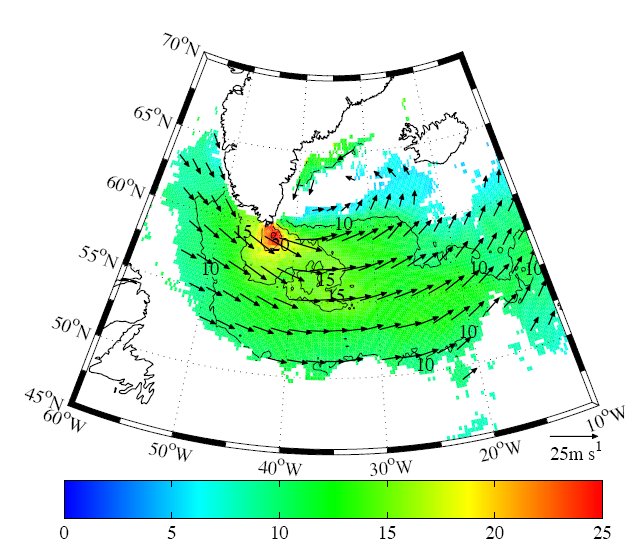
Figure Surface wind speed and wind vectors associated with a composite of Greenland “tip jet” events.
Supervisers: Ian Renfrew (UEA) and Sue Gray (U. Reading)
Greenland has a major influence on the atmospheric circulation of the North Atlantic-Western Europe region; dictating the location and strength of mesoscale weather systems around the coastal seas of Greenland and directly influencing synoptic-scale weather systems both locally and downstream. High winds associated with these weather systems can induce large air-sea fluxes of heat, moisture and momentum in a region that is critical to the overturning of the ocean’s thermohaline circulation and so play a key role in controlling the coupled atmosphere-ocean climate system.
This PhD project will investigate the role of Greenland in defining the structure and the predictability of high-impact weather systems, through a programme of aircraft-based observation and numerical modelling. It is part of the Greenland Flow Distortion Experiment (GFDex) which will provide some of the first detailed in situ observations of the intense atmospheric forcing events that are thought to be important in modifying the ocean in this area but are presently poorly understood. Numerical modelling case studies of the high-impact weather systems will be validated and tuned using the observations, thus providing accurate fields of air-sea heat and moisture fluxes. The dynamics of these weather systems will be investigated: how do they work, what are the important physical mechanisms?
The student will have a fantastic opportunity to take part in the aircraft-based field programme, flying over Greenland and vicinity in March 2007. The student will need to become familiar with the UK Met Office’s “Unified Model”, so a willingness to learn computing skills is important. There will be the opportunity to collaborate with research groups in the UK, Canada, USA and Europe during what will be a very exciting project taking place at the start of the International Polar Year.
Suitable qualifications: Degree in Physics, Mathematics, Meteorology, Oceanography, Geophysical Sciences, Environmental Sciences.

Figure Surface wind speed and wind vectors associated with a composite of Greenland “tip jet” events.